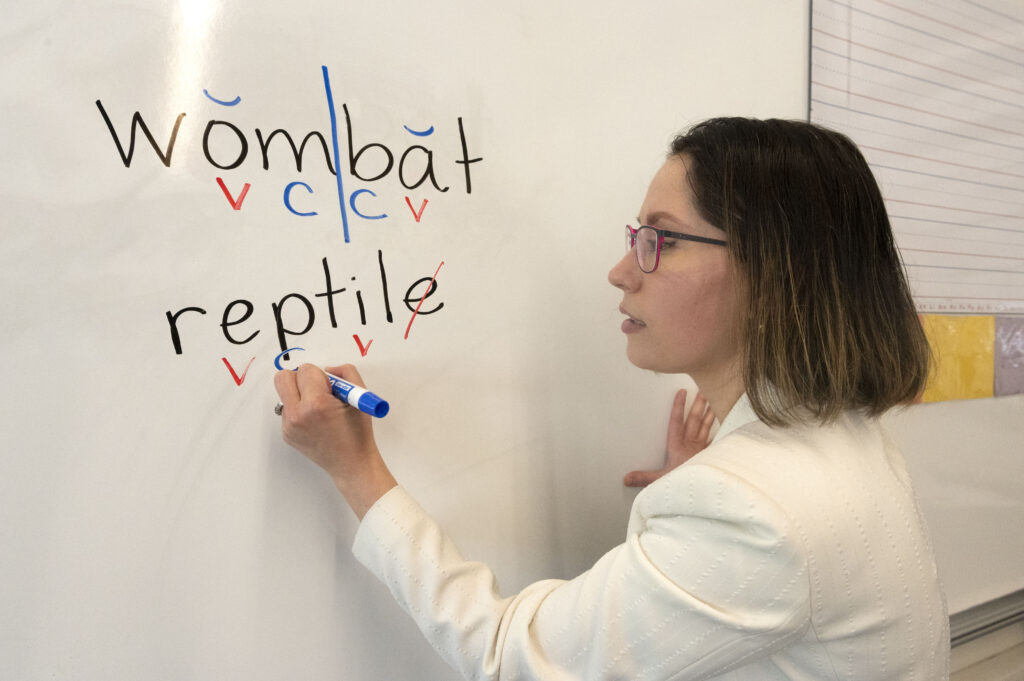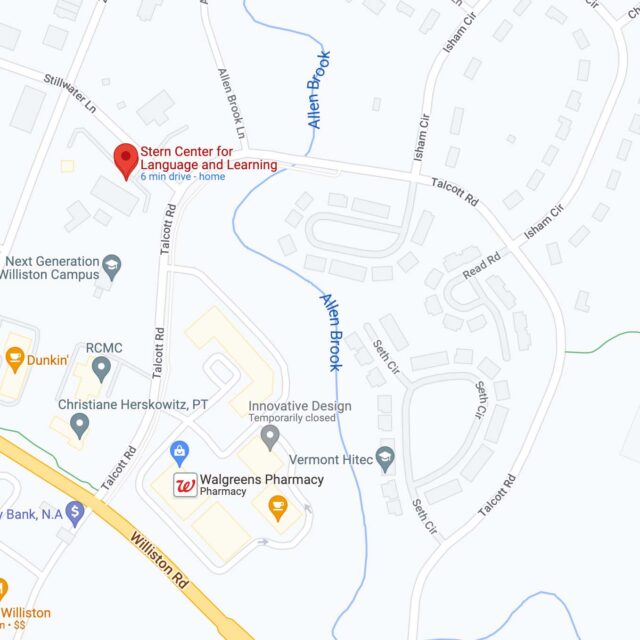
What Is The Orton-Gillingham Approach?
The Orton-Gillingham Approach is a direct and explicit, language-based, and multisensory approach to teaching reading, writing, and spelling. Initially developed in the 1930s by Dr. Samuel T. Orton, a neuropsychiatrist and pathologist, and Anna Gillingham, an educator and psychologist, the Orton-Gillingham (OG) Approach is the underlying foundation of all multisensory structured language instruction, inspiring many creative OG-based programs such as Wilson Language Training®. As the field of neuroscience continues to explore reading and dyslexia, scientists and educators understand more and more why the OG Approach is effective for all learners.
Before we go any further, let me explain a few key terms: Direct and explicit instruction means a teacher never assumes a student will know how to read or write a word without being taught the structure of the word and how this fits into the greater framework of the English language. There is a sequential order to what is taught based on what is more common and predictable in the English language to less common and predictable.
OG teaches literacy through multisensory modalities, using the following acronym: VAKT. V- visual, A- auditory, K- kinesthetic, and T-tactile. We often think of reading as a visual task, but simultaneously utilizing multiple sensory modalities strengthens letter-correspondence, memory, and one’s ability to read and spell. Multisensory instruction is the hallmark of the OG Approach. Example VAKT: Students will be shown letter “d” and will trace the letter on a textured surface, such as a salt tray, while stating the letter-name, keyword, and sound. In this one example, students are seeing a visual symbol, a letter, but are integrating other sensory modalities: Auditory– stating the letter-name and sound Kinesthetic– they are feeling what their mouth is doing when they make this sound (tongue tapping the roof of their mouth and vocal cords vibrating) Tactile– act of handwriting.
In more traditional classrooms, literacy instruction may begin with teaching the letters of the alphabet and letter-sounds with varying degrees of sound accuracy. Teachers will read aloud to students from a variety of children’s literature and expose them to letters, sight words, and texts with the hope that children will learn to read and write through osmosis. There is little to no explicit instruction about the sounds or structure in our language that governs the spelling patterns and sentence structure.
What Does OG In Action Look Like?
A primary classroom that uses an OG Approach to teach literacy will look very different. Children are still exposed to rich literature, but they are also taught systematically through guided exploration and the Socratic method of questioning how sounds are articulated in the mouth to provide greater kinesthetic feedback (i.e., what am I feeling when I make this sound?) when learning letter-sound correspondence. In addition to being taught how letter-sounds are produced, reading and spelling are taught simultaneously because learning how to automatically and legibly form letters strengthens a student’s ability to spell and read. A teacher utilizing the Socratic method continually asks questions to review and expand on what the students have learned, which cultivates critical thinking. Instead of telling the class, “Today we will review closed and open syllables. A closed syllable is…” an OG teacher will ask questions to allow the students to reveal what they know or may have confused. For example, an OG teacher may ask, “Who can give me an example word of a closed syllable” [cat] Why is cat a closed syllable?… What is the vowel sound?… What would the vowel sound be if the ‘t’ was removed in cat?” This form of questioning allows the teacher to pinpoint where student confusion may lie and fosters critical thinking about the English language instead of rote memorization of words.
Why Is It Important?
What I want to emphasize is that while our English language may appear somewhat irregular, in fact, over 90% of words in our language are predictable if we understand the structure and rules within our language. As educators, we must understand the structure of the English language and HOW to teach it in a simple, concrete, easy-to-understand approach. OG is based upon the idea that children should not be taught to memorize word lists for a spelling test, but be given critical thinking skills to think about language. We are teaching to our students’ intellect. Effective literacy instruction is not about rote memorization or “kill and drill.” The reason OG is called an approach, and not a program, is that OG is flexible based on students’ needs. Any skilled teacher needs to know how to adapt to the needs of his or her students beyond what is contained in any one program. A key principle of the OG approach is diagnostic and prescriptive instruction. A skilled teacher takes data on the students’ performance in Monday’s lesson and analyzes the students’ errors to plan Tuesday’s lesson. When students are taught in such a manner it leads to student mastery and improved self-confidence. If the ultimate goal of reading is comprehension and novel thought, we must ensure students can read effortlessly so that their mental energies can be spent on comprehension and are not bogged down with sounding out a word, or even worse, skipping or guessing words.
Who Can Benefit From OG Instruction?
The Orton-Gillingham Approach was originally designed for students with dyslexia or reading disabilities. OG works because this type of instruction teaches to the student’s strength, his or her intelligence instead of rote memorization. Through the diagnostic and prescriptive instruction I mentioned above, students are taught to mastery utilizing multisensory VAKT modalities. OG instruction benefits all students regardless of whether some have learning differences and some do not. For students who are already strong readers, learning OG also improves handwriting, spelling, written expression, and provides students with critical thinking skills they can apply to our English language. As a former kindergarten special education teacher in an inclusion classroom, where students with and without disabilities learn together, my class delighted to discover the new letter of the week. After a few weeks of guiding the class through the oral-motor production of several sounds, my students were independently able to tell me if the new letter of the week made their “motor turn on” (vibration of the vocal folds as in /b/) or kept their “motor off” (as in /p/). Armed with this information about how sounds are articulated, students became better readers and spellers, less likely to confuse similar sounds and letters. Now I have the privilege of visiting classrooms across Vermont, mentoring teachers as part of their Orton-Gillingham training. While observing an OG lesson in a kindergarten classroom, the teacher picked up the new “sight word” for the day, has. Before having time to introduce the new word, a kindergartener excitedly raised her hand and exclaimed, “I know why this is a trick word! The ‘s’ in has says /z/ not /s/.” This young child is not only learning how to read and write but also understands the connection between speech and print within our complex English language.
Rachel Branch, a second through fifth grade English Language Arts teacher at Washington Village School, Vermont reported:
“Since I began implementing OG in my whole class, small group intervention, and one-on-one instruction, I have seen tremendous gains in my students’ ability to read and spell unfamiliar and multisyllabic words. I see it when students effectively use our multisensory routines to spell a word in a story they’re writing. I see it when students come to an unfamiliar word during independent reading and immediately begin to look for syllable types to decode and read it. I hear it when students are writing together and remind each other of the spelling patterns they’ve learned in OG lessons.”
When students have stronger foundational literacy skills, such as the ability to legibly and effortlessly write letters and master letter-sounds and spelling patterns, they can devote more mental energies to higher order reading comprehension and writing skills.
When Should OG Instruction Be Introduced?
Orton-Gillingham instruction should begin when children are first formally taught how to read and write beginning in kindergarten. Teachers are already devoting time to teaching children how to read and write, why not teach it in a direct, explicit, multisensory approach that capitalizes on students’ intellect and critical thinking skills? That’s the way the Central Vermont Supervisory Union saw it anyway when they decided to work with the Stern Center to have their kindergarten through grade 5 classroom teachers and special educators complete Orton-Gillingham coursework and a yearlong practicum. Their students are now meeting or exceeding first grade standards at a higher rate on universal assessments, and classroom teachers have the skills to provide intervention when their students struggle.
People often ask, “When it is too late to effectively remediate poor reading and writing?” It is NEVER too late to improve your reading and writing skills. The oldest student I ever taught was 44-years-old. He began tutoring as functionally illiterate and through his tenacity and OG instruction he learned how to read and spell multisyllabic words. He began text messaging and enrolled in an adult computer class, two things he hadn’t felt confident enough to attempt previously. Our brain remains plastic throughout our lifespan, but the older a child becomes, the greater the gap between his/her low literacy rate and his/her peers’ growing literacy rate becomes. Not only do we need to work on closing this gap to bring an older student up to grade level, but that student has also missed out on years of being exposed to rich vocabulary, sentence structure, and content knowledge from books. The amount of resources necessary to close the gap drastically increases the older a student becomes. Both common sense and the research clearly indicate the earlier we can intervene, the better.
Can I Become Trained In The OG Approach?
In 2010, the Stern Center created an Orton-Gillingham Institute, accredited through the Academy of Orton-Gillingham Practitioners and Educators, to provide comprehensive coursework and practicum opportunities for classroom teachers, special educators, reading specialists, and adult educators. Now in its ninth year, the Stern Center’s Orton-Gillingham Institute offers year-round courses and workshops on the OG Approach. Each fall a new group of educators embarks on a fulfilling yearlong practicum with a mentor or Supervising Fellow to guide them as they learn how to teach OG to their students. For the 2017–18 school year, the Stern Center’s Orton-Gillingham Institute currently has 42 teachers working toward three different levels of OG certification, teaching students as young as kindergarten and up through high school and adult education programs across New England. Andrea McLaughlin, a reading specialist in Barre, Vermont, recently took an Orton-Gillingham course and is pursuing the 100-hour Associate Level practicum. She summed it up best:
“This course was the first time that I heard language can be taught as a science. I think if we thought of reading and spelling more as a science, more students would be successful in schools. Orton and Gillingham thought of language and teaching as a scientific inquiry, systematically connecting students’ learning to earlier learning.”
Literacy is the gateway to success in school and in life. Every child has the right to become a literate member of our society, and every teacher deserves the knowledge and training to make this happen. To learn more about the Stern Center’s Orton-Gillingham Institute and the courses we offer, click here.
[instructor id=”345″]
